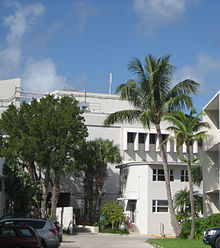Rickenbacker Causeway
Rickenbacker Causeway | |
|---|---|
 Rickenbacker Causeway as seen from Downtown Miami in February 2010 | |
| Coordinates | 25°44′01″N 80°09′45″W / 25.7336°N 80.1624°W |
| Carries | 6 lanes of unsigned |
| Crosses | Biscayne Bay |
| Locale | The Roads, Miami to Key Biscayne |
| Maintained by | FDOT |
| Characteristics | |
| Total length | 5.4 miles (8.7 km) |
| Longest span | 0.6 miles (0.97 km) |
| History | |
| Opened | November 9, 1947[1] |
| Statistics | |
| Toll | $2.25 |
| Location | |
 | |
The Rickenbacker Causeway is a
Background



The Causeway is a toll road, owned and operated by Miami-Dade County. Automobiles traveling southbound from Miami pay a toll of US$2.25[3] as of 2018; northbound traffic is not charged any toll. Tolls are collected via Sunpass; C-Pass transponders or cash are no longer accepted.[4]
In July 2021, Mayor
Also known as (unsigned)
Named after Eddie Rickenbacker, the American World War I flying ace and founder and president of Miami-based Eastern Air Lines, the causeway provides access to the Miami Seaquarium, the University of Miami's Rosenstiel School of Marine, Atmospheric, and Earth Science, MAST Academy, Virginia Key Park, and Miami Marine Stadium on Virginia Key, and to Crandon Park, the Village of Key Biscayne, and Bill Baggs Cape Florida State Park on the island of Key Biscayne.
History
Talk of a bridge to Key Biscayne, Florida inspired by the bridges connecting Miami to Miami Beach, started in 1926. The northern two-thirds of Key Biscayne was owned by William John “W.J.” Matheson, who had established a coconut plantation on the island. In February 1926 Matheson entered into an agreement with land developer D. P. Davis to develop and re-sell the northern half of Key Biscayne, including all of what is now Crandon Park and about half of the present Village of Key Biscayne. Later in 1926 the City of Coral Gables incorporated with Key Biscayne included in its boundaries. There were dreams of a bridge to the island, making Key Biscayne the seaside resort for Coral Gables that Miami Beach had become for Miami.
In March 1926, the
William Matheson died in 1930, leaving the island to his children. There was a flurry of interest in 1939, when the
After the end of World War II, Crandon pushed on with the project. He got financier
In the late 1960s and 1970s the sites along the Rickenbacker Causeway continued to increase in popularity. After increasing in the mid 1960 because of the American television series
But popularity had a price: by 1980 it became evident that the concrete and steel structures supporting the roadway west of Virginia Key needed replacement. Five years later, the high-rise William Powell Bridge and new bridging nearest the toll plaza were built and opened at a cost of $27 million. With exception of the drawbridge (which was removed) the old bridging was left intact to serve as fishing piers.[10] In 2011, the West Fishing Pier was demolished.[11]
Since the opening of the new bridge, the
References
- ^ Henry Cavendish (9 November 1947). "Thousands to See Official Dedication of Causeway, Park". The Miami Daily News. Retrieved 31 May 2012.
- ISBN 0-87530-450-8
- ^ "Rickenbacker Causeway Toll Increases A Quarter To Pay For Bear Cut Bridge Repairs". The Huffington Post. 24 January 2013. Retrieved 14 April 2013.
- ^ Miami-Dade County Online Services. "Rickenbacker Causeway - Miami-Dade County".
- ^ The Miami and Rickenbacker may be privatized. Some Miami Beach residents want out accessed Miami Herald Aug 5 2021
- ^ Cava: KB Will Get Seat At Causeway Table Key Biscayne Independent accessed 8/5/2021
- ^ Florida Department of Transportation, Official Florida Transportation Map 1998
- ^ "Florida @ SouthEastRoads - Florida 913".
- ISBN 1-56164-096-4. pp. 153-162.
- ^ Blank. p. 173.
- ^ "SFI".
